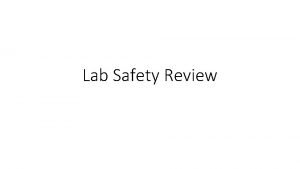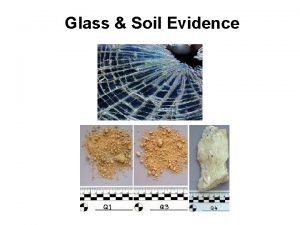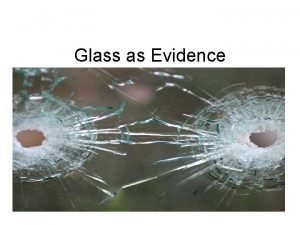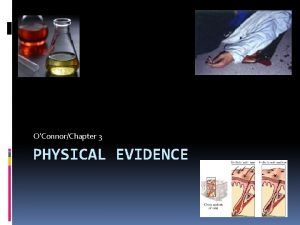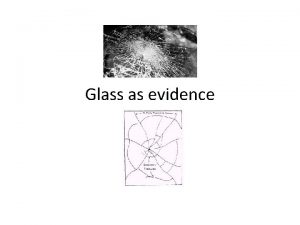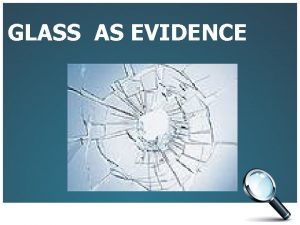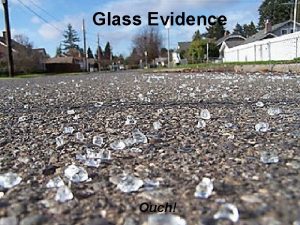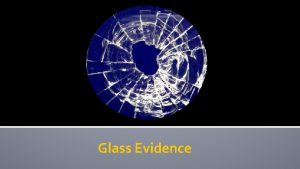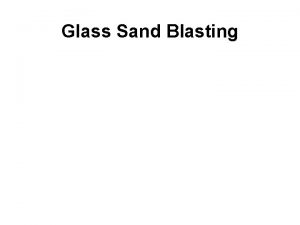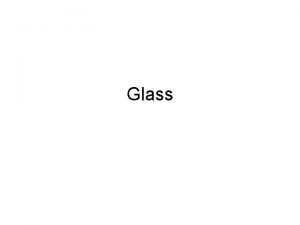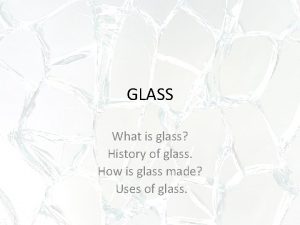GLASS EVIDENCE Common evidence n Found everywhere n



















- Slides: 19

GLASS EVIDENCE Common evidence n Found everywhere n Burglaries n Hit and run accidents n

Types of glass n Soda lime glass – – – Bottles Windows Most common type of glass

Borosilicates n Heat resistant glass – Commonly found in headlight lenses and cookware

Tempered glass Most commonly found in side and rear windows of U. S. autos n Also found in entry doors and shower doors n Fragments into small pieces when broken n

Tempered Glass break

Laminated glass Two sheets of glass with a layer of plastic between n When broken the plastic layer keeps the glass together n Most commonly found in auto windshields n

Proposed legislation n Federal buildings and public safety buildings would be required to use laminated glass. This would reduce the # of injuries in the event of an explosion n This was proposed after the Oklahoma City bombing – many deaths & injuries resulted from flying glass.

Glass at crime scenes n Pieces – Large enough to be physically matched to other pieces – Put back together like a jigsaw puzzle n Particles – Too small to be fit together – analysis will require using the physical properties of the glass – Will provide class characteristic evidence only – Refractive index is the most common property

Fracture patterns Penetration by a projectile creates a cone shape n This can help in determining direction and possibly the angle of penetration n

Glass breaking When the glass breaks two types of cracks form on the glass n The glass actually breaks on the opposite side of the force first n

Radial & concentric cracks Radial crack – begins at the penetration point and travels away from that point n Concentric – form a rough circle around the penetration point n

Radial crack – right angle on reverse side of force

BE CAREFUL… n The opposite will happen in a concentric crack n Make SURE you are dealing with a radial crack n Reconstruction of the window is necessary

This determination is helpful to… n Determine inside and outside of recovered glass n Direction of force n Fingerprints and footwear – inside or outside of glass

Radial crack - From what direction did the force come?

A fracture will stop at a previously existing fracture

When glass breaks… Most of the glass goes in the direction of the force n A lesser amount will come toward the force – for up to 10’ n

Finding glass evidence n Check hair, clothing and shoes (bottom & top) of suspects n Check objects used to break windows or bullets n Collect all available glass as evidence – better luck finding matching edges n Use a druggist fold – not envelopes n Look under vehicles in hit & run cases

Glass in suspect’s shoe
 Logos everywhere
Logos everywhere Data can be found
Data can be found Does hot glass look the same as cold glass
Does hot glass look the same as cold glass Does hot glass look like cold glass
Does hot glass look like cold glass Glass ceiling glass escalator
Glass ceiling glass escalator Glass evidence in forensic science
Glass evidence in forensic science Glass evidence is considered
Glass evidence is considered What are the factors for 54
What are the factors for 54 Greatest common factor of 18 and 27
Greatest common factor of 18 and 27 Lcm of 48 and 60
Lcm of 48 and 60 Common anode and common cathode
Common anode and common cathode Highest common factors and lowest common multiples
Highest common factors and lowest common multiples 56 prime factorization
56 prime factorization Slidetodoc.com
Slidetodoc.com Example of physical evidence
Example of physical evidence Joshua 1:9 csb
Joshua 1:9 csb Linux everywhere
Linux everywhere Zoom meeting
Zoom meeting Hobo spider location map
Hobo spider location map Trips everywhere 2
Trips everywhere 2


